dai-zhang开题报告书-英文
开题报告英文
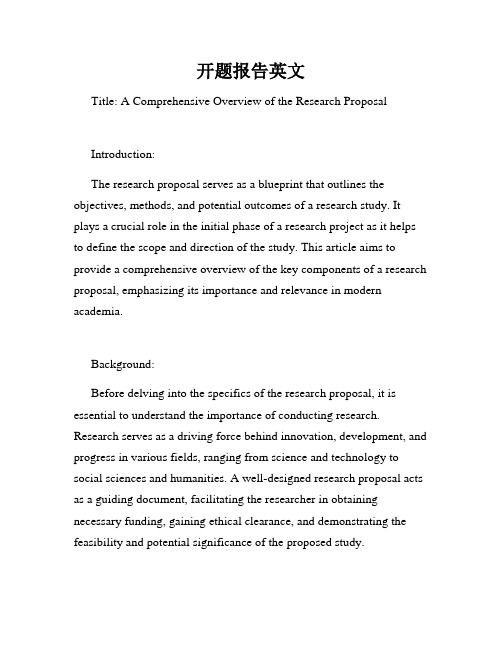
开题报告英文Title: A Comprehensive Overview of the Research ProposalIntroduction:The research proposal serves as a blueprint that outlines the objectives, methods, and potential outcomes of a research study. It plays a crucial role in the initial phase of a research project as it helps to define the scope and direction of the study. This article aims to provide a comprehensive overview of the key components of a research proposal, emphasizing its importance and relevance in modern academia.Background:Before delving into the specifics of the research proposal, it is essential to understand the importance of conducting research. Research serves as a driving force behind innovation, development, and progress in various fields, ranging from science and technology to social sciences and humanities. A well-designed research proposal acts as a guiding document, facilitating the researcher in obtaining necessary funding, gaining ethical clearance, and demonstrating the feasibility and potential significance of the proposed study.Research Problem and Objectives:The research problem is the central issue that the study aims to address. It encapsulates the gap in knowledge or the existing problem that needs to be effectively resolved. The objectives of the research proposal act as signposts, guiding the researcher towards achieving the desired outcomes of the study. Clear, concise, and measurable objectives provide a framework for conducting the research and evaluating its success.Literature Review:The literature review plays a crucial role in the research proposal as it helps to establish the current state of knowledge on the research problem. It involves an in-depth analysis of existing scholarly work, including academic articles, books, and other relevant sources. The literature review not only highlights the existing gaps in knowledge but also allows the researcher to position their study within the broader academic discourse.Methodology:The methodology section of the research proposal outlines the approach and methods that will be employed to collect and analyze data. This section helps to establish the credibility and validity of the study. Depending on the nature of the research, various methodologies such asquantitative, qualitative, or mixed methods can be employed. The researcher needs to describe the sample selection process, data collection techniques, and statistical or analytical tools that will be used to interpret the data.Ethical Considerations:Ethics play a critical role in any research study. In the research proposal, it is essential to address the potential ethical implications of the proposed study and demonstrate how these concerns will be mitigated. This may include obtaining informed consent from participants, ensuring the privacy and confidentiality of data, and complying with institutional review board (IRB) guidelines, where applicable.Expected Outcomes and Significance:The research proposal should clearly outline the anticipated outcomes of the study and its potential significance. These outcomes may include the generation of new knowledge, the development of innovative solutions, or the advancement of existing theories. It is crucial to highlight the potential impact and relevance of the study, both in academia and in practical, real-world applications.Conclusion:In conclusion, the research proposal is a pivotal document in the early stages of a research project. It helps to articulate and refine research questions, establish the importance of the proposed study, and secure necessary approvals and funding. A well-structured research proposal provides a roadmap for the research journey and ensures rigor, integrity, and ethical conduct in the pursuit of knowledge.。
开题报告 英文 格式
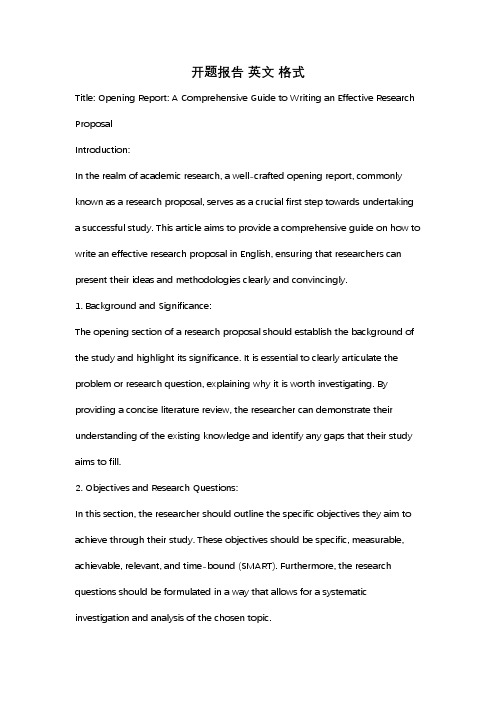
开题报告英文格式Title: Opening Report: A Comprehensive Guide to Writing an Effective Research ProposalIntroduction:In the realm of academic research, a well-crafted opening report, commonly known as a research proposal, serves as a crucial first step towards undertaking a successful study. This article aims to provide a comprehensive guide on how to write an effective research proposal in English, ensuring that researchers can present their ideas and methodologies clearly and convincingly.1. Background and Significance:The opening section of a research proposal should establish the background of the study and highlight its significance. It is essential to clearly articulate the problem or research question, explaining why it is worth investigating. By providing a concise literature review, the researcher can demonstrate their understanding of the existing knowledge and identify any gaps that their study aims to fill.2. Objectives and Research Questions:In this section, the researcher should outline the specific objectives they aim to achieve through their study. These objectives should be specific, measurable, achievable, relevant, and time-bound (SMART). Furthermore, the research questions should be formulated in a way that allows for a systematic investigation and analysis of the chosen topic.3. Methodology:The methodology section details the research design, data collection methods, and analysis techniques that will be employed in the study. It is crucial to provide a clear rationale for the chosen methodology and justify its appropriateness in addressing the research questions. Additionally, ethical considerations and potential limitations should be addressed to ensure the validity and reliability of the study.4. Expected Outcomes and Implications:In this section, the researcher should outline the expected outcomes of the study and discuss their potential implications. It is important to demonstrate how the findings will contribute to the existing body of knowledge and how they can be applied in practical contexts. Clear and concise statements regarding the significance and potential impact of the research are essential in this section.5. Timeline and Budget:A research proposal should include a timeline that outlines the various stages of the study, from data collection to analysis and report writing. This timeline should be realistic and consider any potential challenges or delays that may arise. Furthermore, a budget estimation should be provided, detailing the resources required for the successful completion of the study.6. Conclusion:The conclusion of the research proposal should summarize the main points discussed throughout the document. It should reiterate the significance of thestudy and highlight its potential contributions to the field. Additionally, any potential challenges or limitations should be acknowledged, and strategies for mitigating them should be proposed.Conclusion:Writing an effective research proposal requires careful planning, a clear understanding of the research objectives, and the ability to articulate the significance of the study. By following the structure outlined in this guide, researchers can ensure that their opening report is comprehensive, persuasive, and sets the stage for a successful research endeavor. Remember, a well-written research proposal not only enhances the chances of project approval but also lays the foundation for a rigorous and impactful study.。
开题报告英文模板pdf
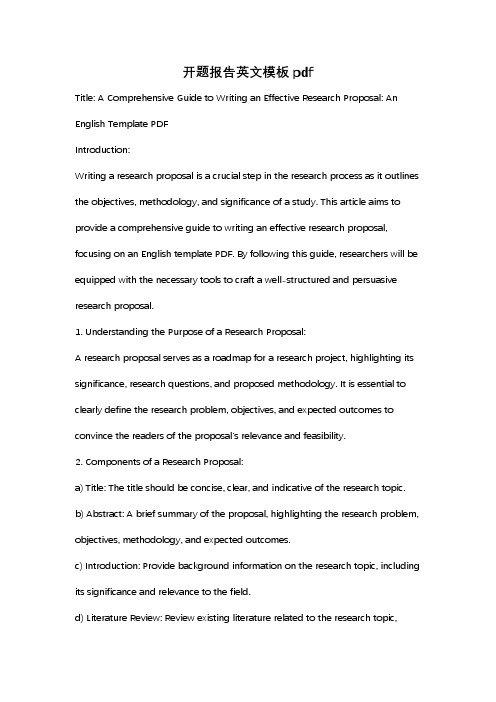
开题报告英文模板pdfTitle: A Comprehensive Guide to Writing an Effective Research Proposal: An English Template PDFIntroduction:Writing a research proposal is a crucial step in the research process as it outlines the objectives, methodology, and significance of a study. This article aims to provide a comprehensive guide to writing an effective research proposal, focusing on an English template PDF. By following this guide, researchers will be equipped with the necessary tools to craft a well-structured and persuasive research proposal.1. Understanding the Purpose of a Research Proposal:A research proposal serves as a roadmap for a research project, highlighting its significance, research questions, and proposed methodology. It is essential to clearly define the research problem, objectives, and expected outcomes to convince the readers of the proposal's relevance and feasibility.2. Components of a Research Proposal:a) Title: The title should be concise, clear, and indicative of the research topic.b) Abstract: A brief summary of the proposal, highlighting the research problem, objectives, methodology, and expected outcomes.c) Introduction: Provide background information on the research topic, including its significance and relevance to the field.d) Literature Review: Review existing literature related to the research topic,identifying gaps and justifying the need for the proposed study.e) Research Questions/Hypotheses: Clearly state the research questions or hypotheses that the study aims to address.f) Methodology: Describe the research design, data collection methods, and analysis techniques to be employed.g) Expected Outcomes: Discuss the anticipated results and their potential implications.h) Timeline: Provide a detailed schedule outlining the various stages of the research project.i) References: Cite all the sources referenced in the proposal using the appropriate citation style.3. Writing Style and Formatting:a) Clarity and Conciseness: Use clear and concise language to convey ideas effectively.b) Grammar and Syntax: Ensure proper grammar and syntax to enhance readability.c) Structure: Organize the proposal into logical sections and paragraphs, maintaining a coherent flow of ideas.d) Formatting: Follow the prescribed formatting guidelines, including font size, margins, and spacing.4. Tips for Writing an Effective Research Proposal:a) Clearly define the research problem and objectives.b) Conduct a comprehensive literature review to identify gaps and justify the need for the proposed study.c) Clearly state the research questions or hypotheses.d) Provide a detailed and feasible methodology.e) Anticipate and address potential limitations and ethical considerations.f) Demonstrate the significance and potential impact of the proposed research.g) Seek feedback from mentors or colleagues to improve the proposal's quality. Conclusion:Writing a research proposal is a critical step in the research process, and an English template PDF can serve as a valuable resource. By understanding the purpose, components, and tips for writing an effective research proposal, researchers can enhance their chances of securing funding and conducting impactful research. Remember, a well-structured and persuasive research proposal is the foundation for a successful research project.。
开题报告英语怎么说

开题报告英语怎么说开题报告英语怎么说在大学学习的过程中,开题报告是一个非常重要的环节。
开题报告是指学生在进行毕业论文或研究项目前,向导师和评审委员会汇报研究计划的一种形式。
那么,在英语中,我们应该如何表达"开题报告"呢?首先,我们可以使用"thesis proposal"来表示"开题报告"。
"Thesis"指的是毕业论文,"proposal"则是提议或计划的意思。
因此,"thesis proposal"可以理解为毕业论文的计划或提议。
这个词组在学术界非常常用,用来描述学生在论文开始之前向导师提出的研究计划。
此外,我们还可以使用"research proposal"来表示"开题报告"。
"Research"意为研究,"proposal"则是提议或计划。
因此,"research proposal"可以理解为研究计划的提议。
与"thesis proposal"相似,"research proposal"也是学术界常用的术语,用来描述学生在开始研究项目之前向导师提出的计划。
除了以上两种常用的表达方式,我们还可以使用"project proposal"来表示"开题报告"。
"Project"意为项目,"proposal"则是提议或计划。
因此,"project proposal"可以理解为项目计划的提议。
这个词组更加广泛,不仅可以用于学术界,还可以用于商业、科研等领域,表示对一个项目的计划和提议。
在开题报告中,我们通常需要介绍研究的背景、目的、方法和预期结果等内容。
开题报告英文版
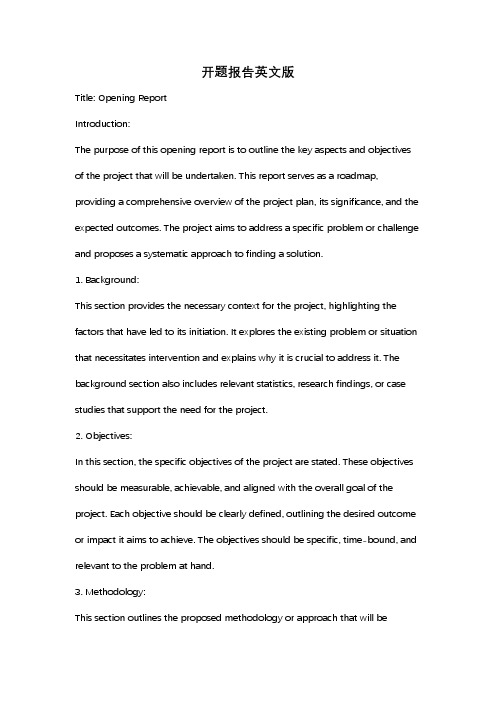
开题报告英文版Title: Opening ReportIntroduction:The purpose of this opening report is to outline the key aspects and objectives of the project that will be undertaken. This report serves as a roadmap, providing a comprehensive overview of the project plan, its significance, and the expected outcomes. The project aims to address a specific problem or challenge and proposes a systematic approach to finding a solution.1. Background:This section provides the necessary context for the project, highlighting the factors that have led to its initiation. It explores the existing problem or situation that necessitates intervention and explains why it is crucial to address it. The background section also includes relevant statistics, research findings, or case studies that support the need for the project.2. Objectives:In this section, the specific objectives of the project are stated. These objectives should be measurable, achievable, and aligned with the overall goal of the project. Each objective should be clearly defined, outlining the desired outcome or impact it aims to achieve. The objectives should be specific, time-bound, and relevant to the problem at hand.3. Methodology:This section outlines the proposed methodology or approach that will beemployed to achieve the project objectives. It may involve a combination of research methods, data collection techniques, analysis procedures, and implementation strategies. The methodology should be logical, feasible, and aligned with the project's objectives. It should also consider any ethical considerations or limitations that may arise during the project's execution.4. Expected Outcomes:This section discusses the anticipated outcomes or deliverables of the project. It highlights the positive changes or improvements that are expected to result from the project's implementation. The expected outcomes should be realistic and directly linked to the project objectives. They may include tangible outputs such as reports, prototypes, or recommendations, as well as intangible outcomes such as increased awareness or behavior change.5. Project Timeline:The project timeline provides a visual representation of the project's key milestones, activities, and their respective durations. It helps to establish a clear timeframe for the project's completion and ensures that all tasks are properly sequenced. The timeline should take into account any dependencies or interdependencies between tasks and allocate sufficient time for potential delays or contingencies.6. Resources:This section outlines the resources required to execute the project successfully. It includes human resources, such as project team members and their roles, as wellas any external expertise or consultants that may be necessary. Additionally, it covers the financial resources needed, including budget estimates and potential sources of funding. The availability of physical resources, such as equipment or facilities, should also be addressed.7. Risk Assessment:A thorough risk assessment is crucial to identify potential obstacles or challenges that may arise during the project's implementation. This section discusses the key risks associated with the project and proposes strategies to mitigate or manage them. It may involve contingency plans, alternative approaches, or stakeholder engagement strategies to address potential risks and ensure project success.Conclusion:In conclusion, this opening report provides a comprehensive overview of the proposed project. It highlights the background, objectives, methodology, expected outcomes, project timeline, resources, and risk assessment. By addressing the identified problem or challenge through a systematic approach, the project aims to achieve tangible and intangible outcomes that will contribute to a positive change or improvement. With the outlined plan and strategies, the project is well-positioned for successful execution and meaningful impact.。
英文开题报告范文
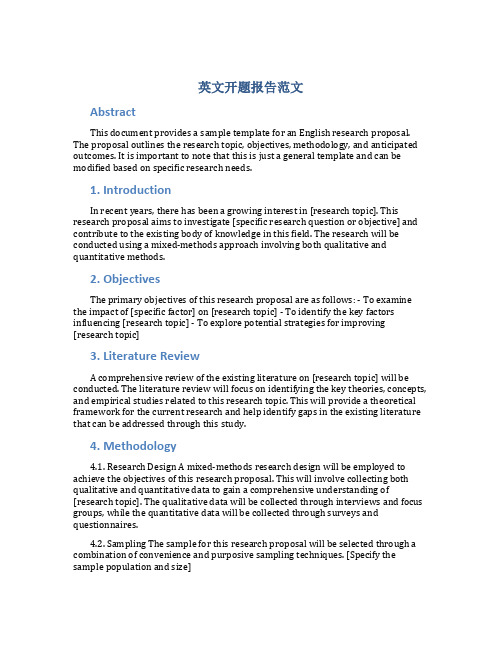
英文开题报告范文AbstractThis document provides a sample template for an English research proposal. The proposal outlines the research topic, objectives, methodology, and anticipated outcomes. It is important to note that this is just a general template and can be modified based on specific research needs.1. IntroductionIn recent years, there has been a growing interest in [research topic]. This research proposal aims to investigate [specific research question or objective] and contribute to the existing body of knowledge in this field. The research will be conducted using a mixed-methods approach involving both qualitative and quantitative methods.2. ObjectivesThe primary objectives of this research proposal are as follows: - To examine the impact of [specific factor] on [research topic] - To identify the key factors influencing [research topic] - To explore potential strategies for improving [research topic]3. Literature ReviewA comprehensive review of the existing literature on [research topic] will be conducted. The literature review will focus on identifying the key theories, concepts, and empirical studies related to this research topic. This will provide a theoretical framework for the current research and help identify gaps in the existing literature that can be addressed through this study.4. Methodology4.1. Research Design A mixed-methods research design will be employed to achieve the objectives of this research proposal. This will involve collecting both qualitative and quantitative data to gain a comprehensive understanding of [research topic]. The qualitative data will be collected through interviews and focus groups, while the quantitative data will be collected through surveys and questionnaires.4.2. Sampling The sample for this research proposal will be selected through a combination of convenience and purposive sampling techniques. [Specify the sample population and size]4.3. Data Collection The data for this research proposal will be collected through various methods, including: - Interviews: Semi-structured interviews will be conducted with [participants] to gain in-depth insights into their experiences and perspectives. - Focus groups: Small group discussions will be conducted to explore different viewpoints and generate more diverse insights. - Surveys: Questionnaires will be distributed to a larger sample to gather quantitative data on [research topic].4.4. Data Analysis The collected data will be analyzed using both qualitative and quantitative data analysis techniques. The qualitative data will be transcribed and coded for themes and patterns, while the quantitative data will be statistically analyzed using relevant software.5. Anticipated OutcomesThe anticipated outcomes of this research proposal are as follows: - Identification of key factors contributing to [research topic] - Development of strategies for improving [research topic] - Validation or refinement of existing theories and concepts related to [research topic]6. ConclusionThis research proposal aims to contribute to the existing body of knowledge on [research topic]. By employing a mixed-methods approach and conducting a comprehensive literature review, this study seeks to address the gaps in the existing literature and provide valuable insights into [research topic]. The anticipated outcomes of this research will have implications for [relevant fields or industries] and may inform the development of future policies and interventions in this area.。
论文开题报告英文版
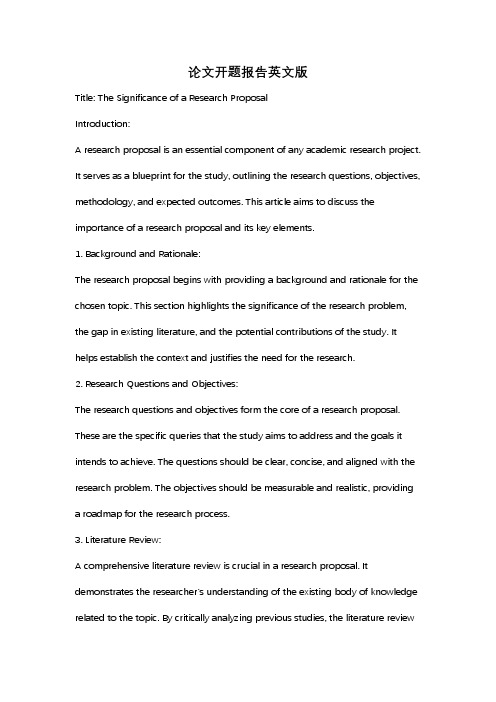
论文开题报告英文版Title: The Significance of a Research ProposalIntroduction:A research proposal is an essential component of any academic research project. It serves as a blueprint for the study, outlining the research questions, objectives, methodology, and expected outcomes. This article aims to discuss the importance of a research proposal and its key elements.1. Background and Rationale:The research proposal begins with providing a background and rationale for the chosen topic. This section highlights the significance of the research problem, the gap in existing literature, and the potential contributions of the study. It helps establish the context and justifies the need for the research.2. Research Questions and Objectives:The research questions and objectives form the core of a research proposal. These are the specific queries that the study aims to address and the goals it intends to achieve. The questions should be clear, concise, and aligned with the research problem. The objectives should be measurable and realistic, providinga roadmap for the research process.3. Literature Review:A comprehensive literature review is crucial in a research proposal. It demonstrates the researcher's understanding of the existing body of knowledge related to the topic. By critically analyzing previous studies, the literature reviewhelps identify gaps, controversies, and areas for further investigation. It also establishes the theoretical framework that will guide the research.4. Methodology:The methodology section outlines the research design, data collection methods, and analysis techniques to be employed. It explains how the research questions will be answered and how the objectives will be achieved. The methodology should be appropriate for the research problem and should address potential limitations and ethical considerations. This section ensures the study's credibility and reliability.5. Expected Outcomes and Significance:In this section, the researcher discusses the anticipated outcomes of the study. These may include new insights, practical applications, or theoretical advancements. The expected outcomes should be realistic and aligned with the research questions and objectives. Additionally, the researcher highlights the significance of the study, emphasizing its potential impact on the academic field or society.6. Timeline and Budget:A research proposal often includes a timeline and budget section. The timeline provides an overview of the research process, indicating the duration of each phase, such as literature review, data collection, and analysis. The budget estimates the financial resources required for the study, including equipment, participant compensation, and research assistance. These sections ensure thefeasibility and practicality of the research.Conclusion:A well-crafted research proposal is essential for any academic research project. It provides a clear direction, justifies the research, and ensures the study's rigor. By addressing the key elements discussed in this article, researchers can develop a comprehensive and persuasive research proposal that increases the chances of project approval and success.。
开题报告英文讲稿范文
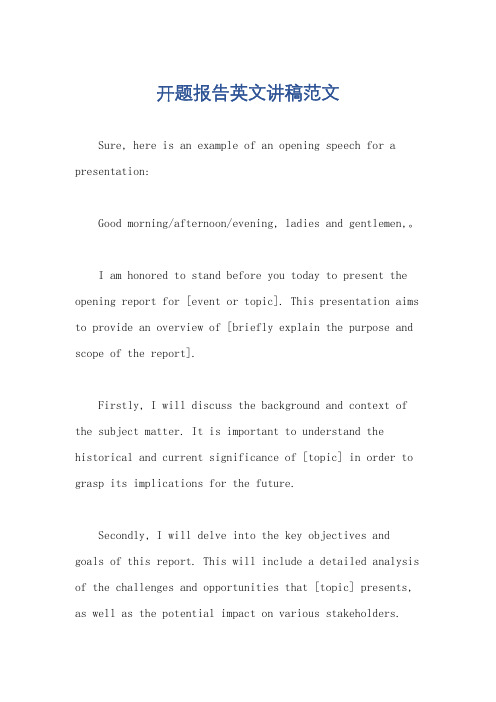
开题报告英文讲稿范文Sure, here is an example of an opening speech for a presentation:Good morning/afternoon/evening, ladies and gentlemen,。
I am honored to stand before you today to present the opening report for [event or topic]. This presentation aims to provide an overview of [briefly explain the purpose and scope of the report].Firstly, I will discuss the background and context of the subject matter. It is important to understand the historical and current significance of [topic] in order to grasp its implications for the future.Secondly, I will delve into the key objectives and goals of this report. This will include a detailed analysis of the challenges and opportunities that [topic] presents, as well as the potential impact on various stakeholders.Next, I will outline the methodology and approach used to gather and analyze the data. It is crucial to establish the credibility and rigor of the research process in order to ensure the validity of the findings.Following this, I will present the main findings and insights that have emerged from the research. This will include a comprehensive overview of the key trends, patterns, and conclusions that have been drawn from the data.Finally, I will conclude the presentation by highlighting the implications and recommendations that arise from the report. This will provide a roadmap for future actions and decisions related to [topic].In conclusion, this opening report aims to set the stage for a deeper exploration of [topic] and to stimulate meaningful discussions and collaborations. I hope that this presentation will serve as a valuable foundation for the rest of the event.Thank you for your attention, and I look forward to engaging with you further on this important topic.。
开题报告英语
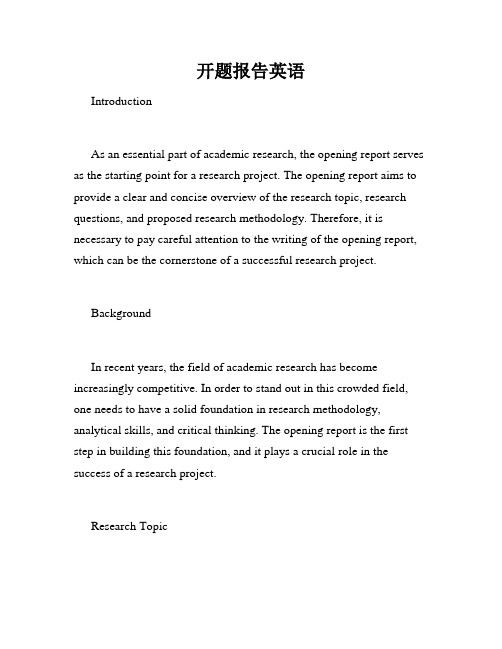
开题报告英语IntroductionAs an essential part of academic research, the opening report serves as the starting point for a research project. The opening report aims to provide a clear and concise overview of the research topic, research questions, and proposed research methodology. Therefore, it is necessary to pay careful attention to the writing of the opening report, which can be the cornerstone of a successful research project.BackgroundIn recent years, the field of academic research has become increasingly competitive. In order to stand out in this crowded field, one needs to have a solid foundation in research methodology, analytical skills, and critical thinking. The opening report is the first step in building this foundation, and it plays a crucial role in the success of a research project.Research TopicThe research topic is the most fundamental part of the opening report. It should be clear, concise, and relevant to current research trends. In choosing a research topic, it is important to consider its practical implications, theoretical significance, and originality. The research topic should be something that is interesting and engaging for both the researcher and the audience.Research QuestionsAfter identifying the research topic, the next step is to formulate research questions. Research questions should be specific, measurable, and address the research gap identified in the research topic. The research questions should be developed in such a way that they lead to the achievement of the research objectives. It is important to ensure that the research questions are feasible, and the data required to answer them is available.Research MethodologyThe research methodology is the plan that outlines how the research will be conducted. It includes the selection of research methods, data collection techniques, and data analysis procedures. The research methodology should be appropriate for the research questions andshould be explained clearly in the opening report. It is essential to ensure that the research methodology is feasible and can be implemented within the available time and resources.Literature ReviewThe literature review is an integral part of the opening report. It provides an overview of previous research related to the research topic and identifies the research gap that the current study aims to fill. The literature review also demonstrates the researcher's familiarity with the research field, and it provides the context for the research questions and methodology. The literature review should be structured logically and should be organized in such a way that it leads to the research questions.ConclusionIn conclusion, the opening report is an essential part of academic research. It sets the stage for the research project and provides a framework for the research methodology. The opening report should be clear, concise, and well-organized. It should include a research topic, research questions, research methodology, and literature review. With careful attention to these elements, the opening report can serve as the foundation for a successful research project.。
英文版开题报告

英文版开题报告英文版开题报告IntroductionThe purpose of this report is to present the outline and key points of my research project. The aim of this project is to investigate the impact of technology on education and its effectiveness in enhancing student learning outcomes. This report will provide an overview of the research topic, research questions, methodology, and expected outcomes.BackgroundIn recent years, technology has become an integral part of our daily lives, revolutionizing various industries, including education. The integration of technology in education has the potential to transform traditional teaching methods and provide students with a more interactive and engaging learning experience. However, it is essential to examine the effectiveness of technology in improving student learning outcomes and identify any potential challenges or limitations.Research Questions1. How does the use of technology in the classroom impact student engagement?2. What are the effects of technology on student learning outcomes?3. What are the challenges and limitations of integrating technology in education?MethodologyTo address the research questions, a mixed-methods approach will be employed. Firstly, a quantitative survey will be conducted among a sample of students to gather data on their perceptions of technology use in the classroom and its impact on their engagement and learning outcomes. The survey will include Likert-scale questions and open-ended questions to capture a comprehensive understanding of the students' experiences.Additionally, qualitative interviews will be conducted with teachers and educational experts to gain insights into the challenges and limitations of integrating technology in education. These interviews will provide valuable perspectives from professionals in the field and help identify potential strategies to overcome any barriers.Expected OutcomesBased on the research findings, it is expected that the use of technology in the classroom will have a positive impact on student engagement. Interactive learning platforms, multimedia resources, and online collaboration tools can enhance student motivation and active participation in the learning process. Furthermore, the research aims to determine whether technology has a significant effect on student learning outcomes. It is hypothesized that technology, when used effectively, can improve student achievement and knowledge retention. The findings will provide evidence-based insights into the effectiveness of technology in education.Lastly, the research will identify the challenges and limitations of integrating technology in education. This will help educators and policymakers understand the potential barriers and develop strategies to address them. Some challenges may include limited access to technology, lack of digital literacy among educators, and the need for ongoing professional development.ConclusionIn conclusion, this research project aims to investigate the impact of technology on education and its effectiveness in enhancing student learning outcomes. By conducting surveys and interviews, the research will provide valuable insights into the perceptions of students, teachers, and experts in the field. The findings will contribute to the existing literature on technology in education and inform educational practices for the future.。
开题报告的英文

开题报告的英文Opening ReportIntroductionThe opening report is an essential part of any research project. It serves as a formal presentation of the proposed research topic, outlining its significance, objectives, methodology, and expected outcomes. In this report, I will discuss the key components of an opening report and provide insights into how to effectively present it in English.BackgroundThe opening report begins with a concise background of the research topic. This section should provide a brief overview of the current state of knowledge in the field and highlight any gaps or limitations that the proposed research aims to address. It is crucial to demonstrate a clear understanding of the existing literature and establish the relevance of the research.Research ObjectivesNext, the research objectives need to be clearly defined. These objectives should be specific, measurable, attainable, relevant, and time-bound (SMART). They serve as a roadmap for the research and help guide the entire project. It is important to align the objectives with the research question and ensure they are realistic and achievable within the given timeframe.MethodologyThe methodology section outlines the research design and approach that will beemployed to achieve the stated objectives. It should include details about the research participants, data collection methods, and data analysis techniques. This section is crucial as it demonstrates the rigor and validity of the proposed research. It is advisable to provide a rationale for the chosen methodology and discuss any potential limitations or challenges that may arise.Expected OutcomesThe expected outcomes section highlights the anticipated results and contributions of the research. It is important to clearly articulate the potential impact of the research findings and how they may advance the current understanding of the topic. This section should also address any potential implications or applications of the research outcomes.Timeline and ResourcesA well-defined timeline is essential for successful project management. This section should outline the key milestones and activities that will be undertaken throughout the research process. Additionally, it is necessary to provide an overview of the resources required to carry out the research, including personnel, equipment, and funding. This demonstrates the feasibility of the project and the researcher's ability to execute it effectively.ConclusionIn conclusion, the opening report serves as a comprehensive overview of the proposed research project. It provides a clear understanding of the research topic, objectives, methodology, expected outcomes, and timeline. A well-presented opening report sets the foundation for a successful research endeavor and allows for effective communication with stakeholders. By carefully addressing each component and ensuring clarity and coherence in the English presentation, researchers can effectively convey the significance and potential impact of their research.。
开题报告模板英语作文

开题报告模板英语作文IntroductionThe opening report is the most important document for a research project. It outlines the background, significance, objectives, research methods, and expected results of the project. This report template aims to provide guidance for researchers to write an effective and comprehensive opening report in English.BackgroundIn this section, the researcher should describe the current state of their research field. It should cover the latest research findings, technological advancements, and discoveries that have impacted the area of investigation.For example, in the field of artificial intelligence, recent works have focused on deep learning and machine vision. These have revolutionized how machines are trained to perform complex tasks, such as image recognition and natural language processing.Research ObjectivesThe research objectives should specify the goals of the research project. It should clearly state what the researcher aims to achieve through the research. Objectives should be SMART (Specific, Measurable, Achievable, Realistic, and Time-bound). This means that they should be clear, quantifiable, attainable, feasible, and have a timeframe.For example, in the field of AI, a SMART objective might be:。
开题报告 英语

开题报告英语IntroductionThe purpose of this report is to present the key points and objectives for my upcoming research project. This research project aims to explore the impact of technology on language learning, focusing specifically on English language acquisition. The report will outline the background, research questions, methodology, and expected outcomes of the study.BackgroundIn recent years, the rapid development of technology has greatly influenced various aspects of our lives, including education. As language learning is a complex process, the integration of technology in language classrooms has become a significant area of research. English, as the lingua franca of the modern era, has experienced a particular surge in technology-assisted language learning. Thus, it is crucial to investigate the effectiveness and potential implications of technology in enhancing English language acquisition.Research QuestionsIn order to gain a comprehensive understanding of the impact of technology on English language learning, the following research questions will guide the study:1. How does the use of technology affect English language proficiency among learners?This question aims to explore the correlation between technology integration and language proficiency. It will investigate whether technology can enhance language learning outcomes, such as speaking, listening, reading, and writing skills.2. What are the advantages and disadvantages of using technology in English language classrooms?This question will investigate the benefits and drawbacks of incorporating technology in language learning. It will consider factors such as increased motivation, accessibility to authentic resources, potential distractions, and learner autonomy.MethodologyTo address the research questions, a mixed-methods approach will be employed. Firstly, a quantitative survey will be conducted to gather data from a large sample of English language learners. The survey will assess their perception of technology's impact on their language learning process, as well as their overall English language proficiency. Additionally, qualitative data will be collected through interviews and observations of English language teachers. The focus will be on understanding their experiences, challenges, and the strategies they employ when incorporating technology in their classrooms.Expected OutcomesThe expected outcomes of this research project are as follows:1. Enhanced understanding of the impact of technology on English language learning:By analyzing the survey data and conducting interviews with language teachers, this study aims to provide insights into the effects of technology on English language acquisition. This will help educators and policymakers make informed decisions regarding the integration of technology in language classrooms.2. Identification of best practices and strategies for incorporating technology:Through interviews with English language teachers, the research will identify effective instructional strategies and best practices for integrating technology in language classrooms. This will provide practical guidance to educators who wish to enhance their teaching methods using technology.ConclusionIn conclusion, this report has outlined the key points and objectives for my research project on the impact of technology on English language learning. The research questions, methodology, and expected outcomes have been presented. By investigating the relationship between technology and language proficiency, as well as identifying the advantages and disadvantages of technology integration, this study aims to contribute to the ongoing discussion on technology-assisted language learning. Ultimately, the findings will be valuable for educators, learners, and policymakers involved in English language education.。
开题报告 英文版
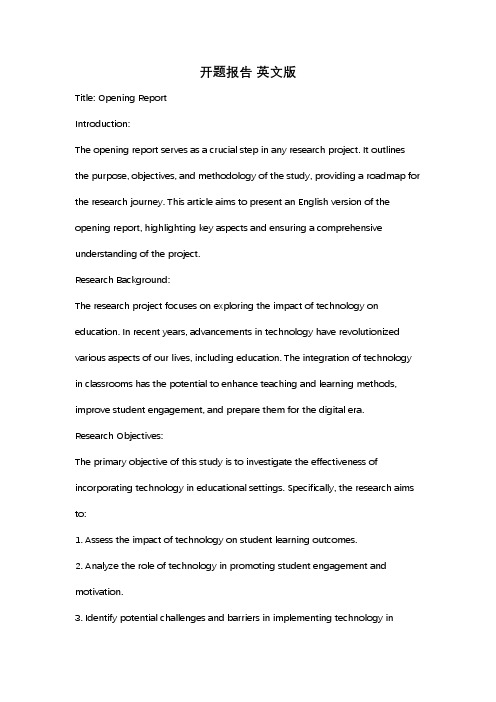
开题报告英文版Title: Opening ReportIntroduction:The opening report serves as a crucial step in any research project. It outlines the purpose, objectives, and methodology of the study, providing a roadmap for the research journey. This article aims to present an English version of the opening report, highlighting key aspects and ensuring a comprehensive understanding of the project.Research Background:The research project focuses on exploring the impact of technology on education. In recent years, advancements in technology have revolutionized various aspects of our lives, including education. The integration of technology in classrooms has the potential to enhance teaching and learning methods, improve student engagement, and prepare them for the digital era.Research Objectives:The primary objective of this study is to investigate the effectiveness of incorporating technology in educational settings. Specifically, the research aims to:1. Assess the impact of technology on student learning outcomes.2. Analyze the role of technology in promoting student engagement and motivation.3. Identify potential challenges and barriers in implementing technology ineducation.4. Explore best practices and strategies for successful integration of technologyin classrooms.Research Methodology:To achieve the research objectives, a mixed-methods approach will be employed. This approach combines qualitative and quantitative data collection and analysis techniques, ensuring a comprehensive understanding of the research topic. The following methods will be utilized:1. Surveys: A structured questionnaire will be distributed to teachers and students to gather quantitative data on their perceptions and experiences regarding technology integration.2. Interviews: In-depth interviews will be conducted with educators, administrators, and technology experts to gain insights into the challenges and best practices of incorporating technology in education.3. Classroom Observations: Observations will be made in selected classrooms to assess the impact of technology on student engagement and learning outcomes.4. Literature Review: A comprehensive review of existing literature will be conducted to gather relevant information and theoretical frameworks related to technology integration in education.Expected Outcomes:Based on the research objectives and methodology, the following outcomes are expected:1. Insights into the impact of technology on student learning outcomes, including academic achievement and skill development.2. Identification of strategies and best practices for effectively integrating technology in classrooms.3. Understanding of potential challenges and barriers in implementing technology in education and recommendations for overcoming them.4. Recommendations for policymakers, educators, and institutions on incorporating technology in education to enhance teaching and learning experiences.Conclusion:The opening report provides an overview of the research project on the impact of technology on education. By employing a mixed-methods approach, the study aims to explore the effectiveness of technology integration, identify challenges, and propose best practices. The expected outcomes will contribute to the existing body of knowledge on technology in education and provide valuable insights for educators and policymakers alike. As the research progresses, further analysis and findings will be shared in subsequent reports.。
开题报告英文怎么说
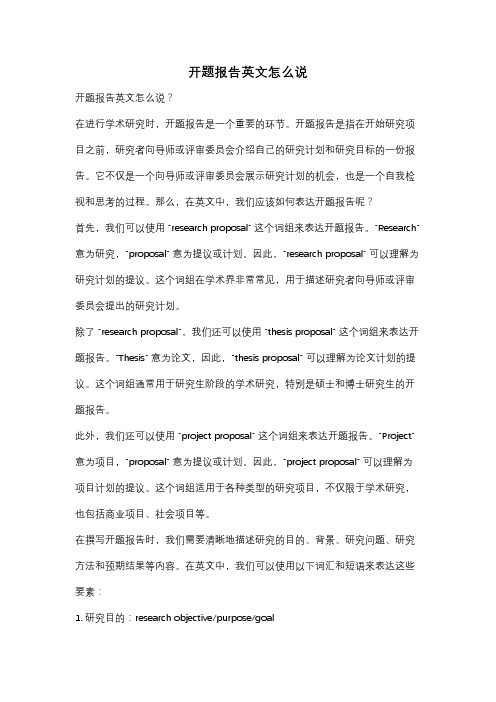
开题报告英文怎么说开题报告英文怎么说?在进行学术研究时,开题报告是一个重要的环节。
开题报告是指在开始研究项目之前,研究者向导师或评审委员会介绍自己的研究计划和研究目标的一份报告。
它不仅是一个向导师或评审委员会展示研究计划的机会,也是一个自我检视和思考的过程。
那么,在英文中,我们应该如何表达开题报告呢?首先,我们可以使用 "research proposal" 这个词组来表达开题报告。
"Research" 意为研究,"proposal" 意为提议或计划。
因此,"research proposal" 可以理解为研究计划的提议。
这个词组在学术界非常常见,用于描述研究者向导师或评审委员会提出的研究计划。
除了 "research proposal",我们还可以使用 "thesis proposal" 这个词组来表达开题报告。
"Thesis" 意为论文,因此,"thesis proposal" 可以理解为论文计划的提议。
这个词组通常用于研究生阶段的学术研究,特别是硕士和博士研究生的开题报告。
此外,我们还可以使用 "project proposal" 这个词组来表达开题报告。
"Project" 意为项目,"proposal" 意为提议或计划。
因此,"project proposal" 可以理解为项目计划的提议。
这个词组适用于各种类型的研究项目,不仅限于学术研究,也包括商业项目、社会项目等。
在撰写开题报告时,我们需要清晰地描述研究的目的、背景、研究问题、研究方法和预期结果等内容。
在英文中,我们可以使用以下词汇和短语来表达这些要素:1. 研究目的:research objective/purpose/goal2. 研究背景:research background/context3. 研究问题:research question/problem4. 研究方法:research methodology/approach5. 预期结果:expected results/outcomes此外,我们还可以使用以下词汇和短语来描述开题报告中的其他要素:1. 文献综述:literature review2. 研究范围:scope of research3. 研究限制:research limitations4. 时间安排:timeline/schedule5. 预算估算:budget estimation6. 参考文献:references/bibliography在撰写开题报告时,我们需要注意语法和句子结构的准确性。
开题报告 英文模板
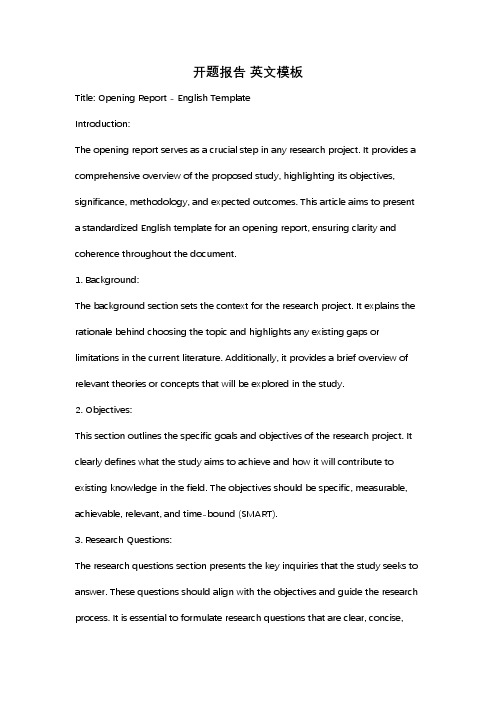
开题报告英文模板Title: Opening Report - English TemplateIntroduction:The opening report serves as a crucial step in any research project. It provides a comprehensive overview of the proposed study, highlighting its objectives, significance, methodology, and expected outcomes. This article aims to present a standardized English template for an opening report, ensuring clarity and coherence throughout the document.1. Background:The background section sets the context for the research project. It explains the rationale behind choosing the topic and highlights any existing gaps or limitations in the current literature. Additionally, it provides a brief overview of relevant theories or concepts that will be explored in the study.2. Objectives:This section outlines the specific goals and objectives of the research project. It clearly defines what the study aims to achieve and how it will contribute to existing knowledge in the field. The objectives should be specific, measurable, achievable, relevant, and time-bound (SMART).3. Research Questions:The research questions section presents the key inquiries that the study seeks to answer. These questions should align with the objectives and guide the research process. It is essential to formulate research questions that are clear, concise,and capable of generating meaningful insights.4. Methodology:The methodology section describes the research design, data collection methods, and data analysis techniques that will be employed. It explains why the chosen methods are appropriate for addressing the research questions and achieving the objectives. This section should also address any ethical considerations and potential limitations of the chosen methodology.5. Significance:In this section, the significance of the research project is discussed. It highlights the potential contributions the study will make to the academic field, practical applications, or societal impact. The significance can be related to filling gaps in knowledge, advancing theoretical frameworks, or providing practical solutions to real-world problems.6. Expected Outcomes:The expected outcomes section outlines the anticipated results of the study. It may include both qualitative and quantitative findings, as well as potential implications of these findings. This section should align with the research questions and objectives, providing a clear picture of the expected contributions of the research.7. Timeline:The timeline section provides a schedule for the research project, outlining the key milestones and activities. It helps to ensure that the research is conductedwithin a reasonable timeframe and allows for effective project management. The timeline should be realistic and consider any potential challenges or delays that may arise.8. Resources:This section identifies the resources required to conduct the research project successfully. It includes both human resources, such as researchers and participants, and material resources, such as equipment, software, or funding. This section should demonstrate that the necessary resources are available or can be obtained to support the research.Conclusion:The opening report is a crucial document that sets the foundation for a research project. By following a standardized English template, researchers can ensure that all essential aspects of the study are adequately addressed. This article provided a comprehensive guide, covering various sections including background, objectives, research questions, methodology, significance, expected outcomes, timeline, and resources. By utilizing this template, researchers can effectively communicate their research plans and set the stage for a successful study.。
开题汇报发言稿英语范文

Good morning! It is my great honor to stand here today to present my research topic for the opening report. My topic is "The Impact of Social Media on Youth Mental Health".Firstly, I would like to express my gratitude to the organizing committee for providing this opportunity to present my research topic. I would also like to thank my supervisors for their guidance and support throughout the research process.The rapid development of technology has brought about significant changes in our lives, and social media has become an indispensable part of our daily life. With the popularity of social media platforms such as WeChat, Weibo, and TikTok, more and more young people are spending a considerable amount of time on these platforms. However, the influence of social media on youth mental health has become a hot topic in recent years, and it has attracted the attention of the public and scholars.In this research, I aim to explore the following aspects:1. The prevalence of social media usage among young people.2. The types and characteristics of social media content that may affect youth mental health.3. The impact of social media on youth mental health, including positive and negative effects.4. The factors that influence the relationship between social media and youth mental health.5. Recommendations for promoting the healthy use of social media among young people.To achieve these objectives, I will adopt the following research methods:1. Literature review: I will conduct a comprehensive review of relevant literature to understand the existing research on the impact of social media on youth mental health.2. Questionnaire survey: I will design a questionnaire to collect data on social media usage, mental health status, and other relevant factors among young people.3. Case study: I will select several typical cases to analyze the specific impact of social media on youth mental health.4. Statistical analysis: I will use statistical methods to analyze the collected data and draw conclusions.Now, let me introduce the structure of my research report:1. IntroductionIn this section, I will introduce the background and significance of the research topic, as well as the research objectives and methodology.2. Literature reviewIn this section, I will summarize the existing research on the impact of social media on youth mental health, including the theoretical framework and research findings.3. MethodologyIn this section, I will describe the research design, data collection, and data analysis methods used in this study.4. ResultsIn this section, I will present the findings of the research, including the prevalence of social media usage, the types and characteristics of social media content, and the impact of social media on youth mental health.5. DiscussionIn this section, I will analyze the results of the research, discuss the limitations of the study, and compare the findings with previous research.6. ConclusionIn this section, I will summarize the main findings of the research and provide recommendations for promoting the healthy use of social media among young people.Now, let me highlight some key points of my research:1. The prevalence of social media usage among young people is high, and the types and characteristics of social media content are diverse. Among them, content related to beauty, fashion, and celebrities has a significant impact on youth mental health.2. The impact of social media on youth mental health is both positive and negative. On the one hand, social media can help young people expand their social circles, enhance their communication skills, and promote their self-expression. On the other hand, excessive use of social media may lead to psychological pressure, anxiety, and depression.3. The relationship between social media and youth mental health is influenced by various factors, such as the individual's personality, social environment, and family background.Based on the above findings, I will provide the following recommendations:1. Strengthen the education and guidance of young people on the healthy use of social media.2. Promote the development of positive and healthy social media content.3. Pay attention to the mental health of young people and provide timely psychological counseling and support.In conclusion, my research on the impact of social media on youth mental health aims to provide a comprehensive understanding of the issue and contribute to the development of effective strategies for promoting the healthy use of social media among young people. I believe that this research will have practical significance for the prevention and treatment of mental health problems among young people.Thank you for your attention and support. I look forward to your valuable comments and suggestions.This is the end of my opening report. Thank you!。
开题报告英文附录范文

开题报告英文附录范文Appendix1. Survey QuestionnaireDear respondent,Thank you for taking the time to complete this questionnaire. The purpose of this survey is to gather information about consumers' preferences and behaviors regarding online shopping. Your responses will be anonymous and will only be used for research purposes.Please check the box that best applies to you or provide your own response where necessary.1. Gender:- Male- Female- Prefer not to say2. Age:- Under 18- 18-25- 26-35- 36-45- 46-55- 56 and above3. How often do you shop online?- Daily- Weekly- Monthly- Once in a while- Never4. What is your main reason for shopping online?- Convenience- Better prices- Wider selection- Avoiding crowds- Other (please specify)5. Which factors are most important to you when selecting an online store? (Rank from most important to least important) - Price- Product quality- Customer reviews- Delivery options- Return policy- Website design and usability- Other (please specify)6. Have you ever experienced any issues or problems when shopping online? (Select all that apply)- Late delivery- Damaged or defective products- Poor customer service- Difficulty making returns- Security concerns (e.g., credit card information)- Other (please specify)- None7. How likely are you to recommend online shopping to others? - Very likely- Likely- Neutral- Unlikely- Very unlikely8. In your opinion, what could online stores do to improve the shopping experience?Thank you for participating in this survey. Your feedback is greatly appreciated.。
开题报告 英文
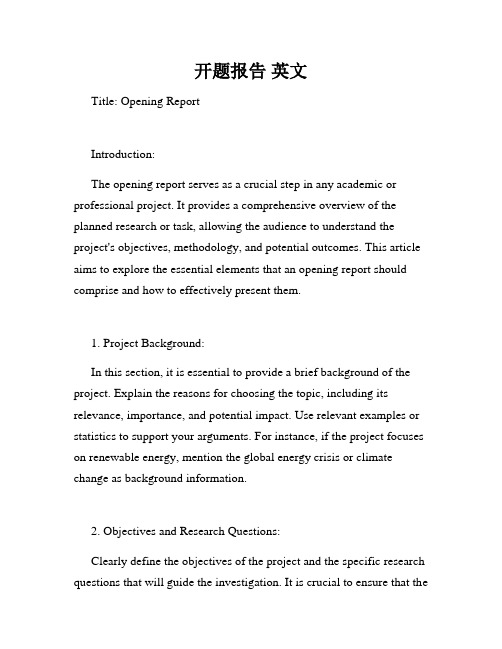
开题报告英文Title: Opening ReportIntroduction:The opening report serves as a crucial step in any academic or professional project. It provides a comprehensive overview of the planned research or task, allowing the audience to understand the project's objectives, methodology, and potential outcomes. This article aims to explore the essential elements that an opening report should comprise and how to effectively present them.1. Project Background:In this section, it is essential to provide a brief background of the project. Explain the reasons for choosing the topic, including its relevance, importance, and potential impact. Use relevant examples or statistics to support your arguments. For instance, if the project focuses on renewable energy, mention the global energy crisis or climate change as background information.2. Objectives and Research Questions:Clearly define the objectives of the project and the specific research questions that will guide the investigation. It is crucial to ensure that theobjectives are achievable and measurable. The research questions should be focused and aligned with the project's overall goals. For example, if the project aims to explore the impact of social media on youth mental health, the research questions could revolve around examining usage patterns, identifying potential risks, and suggesting interventions.3. Literature Review:Conducting a thorough literature review is vital to demonstrate a comprehensive understanding of the existing knowledge on the chosen topic. Discuss the major theories, concepts, and studies related to the project and identify any gaps in the current research. Analyze different perspectives and arguments while critically evaluating the strengths and weaknesses of existing findings. This section will assist in developing a solid theoretical framework for the project.4. Methodology:Explain the proposed research methodology and the reasons behind its selection. Whether it is quantitative, qualitative, or a combination of both, provide a rationale for choosing a particular approach. Outline the data collection methods, such as surveys, interviews, or laboratory experiments, and briefly discuss how the data will be analyzed. Ensurethat ethical considerations, such as informed consent and data privacy, are addressed.5. Work Plan and Timeline:Present a clear work plan outlining the different stages of the project and their estimated timeframes. Break down the tasks into smaller, manageable components and allocate specific durations for each. This will help in organizing and tracking the progress of the project. Consider utilizing project management tools to create visual representations, such as Gantt charts, to illustrate the timeline effectively.6. Expected Results and Potential Contribution:Discuss the anticipated results and the potential contribution of the project to the field of study. Highlight the significance of the findings and their implications for theory and practice. Emphasize how the project fills the identified gaps in existing literature and offers new insights. This section should convey the project's value and justify the resources allocated to it.Conclusion:The opening report sets the foundation for the successful execution of any academic or professional project. By providing a clear overview of the project's background, objectives, methodology, and expected outcomes, it ensures that all stakeholders are aligned and have a shared understanding. Effectively communicating the relevance and potential impact of the project will help in garnering support and resources necessary for its completion.。
英文开题报告
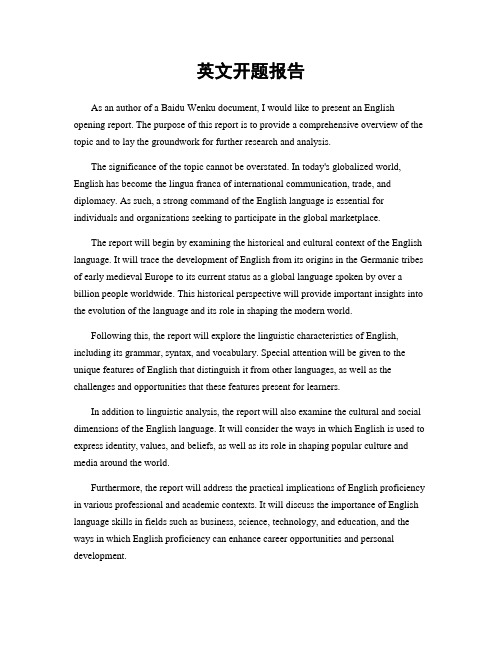
英文开题报告As an author of a Baidu Wenku document, I would like to present an English opening report. The purpose of this report is to provide a comprehensive overview of the topic and to lay the groundwork for further research and analysis.The significance of the topic cannot be overstated. In today's globalized world, English has become the lingua franca of international communication, trade, and diplomacy. As such, a strong command of the English language is essential for individuals and organizations seeking to participate in the global marketplace.The report will begin by examining the historical and cultural context of the English language. It will trace the development of English from its origins in the Germanic tribes of early medieval Europe to its current status as a global language spoken by over a billion people worldwide. This historical perspective will provide important insights into the evolution of the language and its role in shaping the modern world.Following this, the report will explore the linguistic characteristics of English, including its grammar, syntax, and vocabulary. Special attention will be given to the unique features of English that distinguish it from other languages, as well as the challenges and opportunities that these features present for learners.In addition to linguistic analysis, the report will also examine the cultural and social dimensions of the English language. It will consider the ways in which English is used to express identity, values, and beliefs, as well as its role in shaping popular culture and media around the world.Furthermore, the report will address the practical implications of English proficiency in various professional and academic contexts. It will discuss the importance of English language skills in fields such as business, science, technology, and education, and the ways in which English proficiency can enhance career opportunities and personal development.Finally, the report will conclude with a discussion of the future of the English language. It will consider the impact of globalization, technology, and demographic trends on the spread and evolution of English, as well as the challenges and opportunities that these developments present for individuals and societies.In conclusion, this opening report aims to provide a comprehensive and insightful overview of the English language and its significance in the modern world. By examining the historical, linguistic, cultural, and practical dimensions of English, the report seeks to lay the foundation for further research and analysis in this important area of study.。
- 1、下载文档前请自行甄别文档内容的完整性,平台不提供额外的编辑、内容补充、找答案等附加服务。
- 2、"仅部分预览"的文档,不可在线预览部分如存在完整性等问题,可反馈申请退款(可完整预览的文档不适用该条件!)。
- 3、如文档侵犯您的权益,请联系客服反馈,我们会尽快为您处理(人工客服工作时间:9:00-18:30)。
By comparison, the domestic study on Ash-Wednesday is not enough.
<}0{>
<0}
Ash-Wednesday marks a turning point in the poet’s intellectual development and poetic technique. It is evident that the critics in general are aware of the personal and religious allusions that occur in Ash-Wednesday. Comprehensive surveying the study on Ash-Wednesday at home and abroad, it can be found that some deal with Lent liturgy and personal conversion, some connect Dante with Eliot, some treat the image as mystical experience.
consolidation of racial freedom
3.1 Writing as a battlefield of various voices
3.2 White racists’ domination over the Other through writing
3.3 rewriting history and reconstructing racial relationship
Chapter Four Three successive ways as a phenomenological process of racial politics
4.1 Johnson’s philosophical and aesthetic thoughts
4.2 reflections in Middle Passage
1.3 limitations and dangers
Chapter Two Loving the Other: a way to genuine freedom
2.1 socio-economic and philosophical conditions for Johnson’s multiculturalism
Hugh Kenner, in her The Invisible Poet: T. S. Eliot (1959), thinks highly of Ash-Wednesday from its language, image and rhythm, and she argues that this poem is the new stage of Eliot’s poetry. But only the reader follows the sense of tradition which Eliot advocated and compares it with the early poems Eliot wrote, can he understand the differences of poetic feature and spiritual development in the poems. In this way the clear idea Eliot’s whole poetry will get
“Victory Without Defeating the Other”: Charles Johnson’sMiddle Passageas an Allegory of Racial Politics
研
究
生
姓名
Dai Huan
学籍号
0812113
入学年月
September, 2008
学院
School of Foreign Studies
According to Eliot, a poet must have the “historical sense”, which needs “a perception of its pastness of the past and its presence”, which makes a man write with “a feeling of the whole literature of Europe from Homer and within it the whole literature of his own country has a simultaneous existence and composes a simultaneous order.” No matter how his own personal voice exists in his later poems, this kind of “historical sense” works all along his poetry.
4.3 an allegory for the contemporary republic
Conclusion
II.立论依据
II-1研究意义
{0>In the immense amount of critical opinion on Eliot’s The Waste Land (1921) and Four Quartets (1943), we can find constant reference to the change in his poetic tone and technique.<}0{>骨灰盒科技含量<0}{0>And this change was reflected in Ash-Wednesday which was published as a whole in 1930. The foreign scholars have done to some degree comprehensive study on this poem from various aspects such as the images and allusions, the rhythm and the rhyme, poet’s personal experience and intellectual development, the echoes of Medieval Writers and of seventeen writers, the religious liturgy and the divine love.<}0{>And this change was reflected in Ash-Wednesday which was published as a whole in 1930. The foreign scholars have done to some degree comprehensive study on this poem from various aspects such as the images and allusions, the rhythm and the rhyme, poet’s personal experience and intellectual development, the echoes of Medieval Writers and of seventeen writers, the religious liturgy and the divine love.<0}
II-2国内外研究现状(附中英文参考书目)
Although there are in China few researches on Charles Johnson, there has been a great deal of attention on both his fiction and non-fiction works which are attracting more and more American scholars. Among his four novels, Oxherdingtale and Middle Passage, in the form of the “neo-slave narrative”, are the main attractions for scholars, with the latter more well-known and popular because of its representation of the author’s more mature craftsmanship. Up till now, there have been 8 monographs on his four novels and more than 40 journal articlesexclusivelyon Middle Passage. Since Middle Passage is generally considered as both a “black philosophical fiction” and “neo-slave narrative”, scholarship focuses mainly on its philosophical,cultural, and politicalimplications and the author’s literary innovations.
Introduction
Chapter One Eating the Other: dualist racial politics in an oppressor-oppressed situation
1.1 socio-economic and philosophical roots
